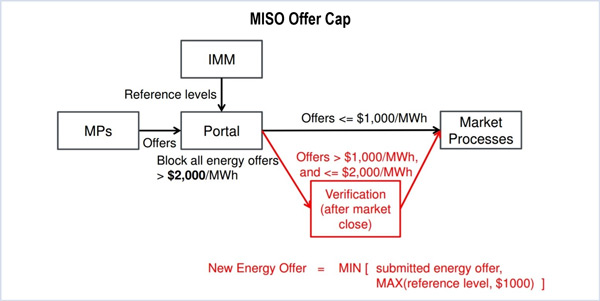By Amanda Durish Cook
CARMEL, Ind. — MISO is considering how to alter its market rules to comply with a FERC order that “softens” the current energy offer cap and establishes a higher “hard” cap for cost-based offers.
One potential change: The RTO could possibly increase its maximum value of lost load (VoLL), which represents the estimated amount that firm electricity customers would be willing to pay to avoid losing service. The VoLL, established in 2005, caps LMPs at $3,500/MWh. MISO is the only RTO to enforce such a cap.
“We really should update the value of lost load,” Chuck Hansen, MISO senior market engineer, said during a March 9 Market Subcommittee meeting. “It’s been around for a decade. It’s probably time to refresh that number.”
Hansen said MISO is hoping to implement FERC’s directive by winter 2017/18, although the scope of the market changes could vary from adjusting the VoLL to ending LMP caps altogether.
Order 831 replaces the current energy offer cap of $1,000/MWh with a soft cap of $1,000 and a hard cap of $2,000 for verified cost-based incremental offers. MISO’s offer portal will be reprogrammed to automatically block all offers above $2,000/MWh, while offers between $1,000 and $2,000/MWh will be verified only after the daily market close.
A resource may qualify for uplift payments if legitimate offers above $1,000/MWh cannot be verified quickly enough. For the past three winters, FERC has granted MISO a waiver on the RTO’s energy offer cap policy. (See MISO Granted Winter Waiver on Offer Cap.)
“We have not seen offers above $1,000 yet in MISO,” said Jeff Bladen, MISO executive director of market design. “The degree to which we could see them is just too hard to predict, [but] the likelihood that we see offers above $1,000 or $2,000 — [in] my view is it’s pretty unlikely because we haven’t seen it before.”
Hansen said MISO’s Independent Market Monitor will adapt to the new offer cap by stepping up its monitoring efforts next winter, updating resource reference levels as it keeps tabs on natural gas prices throughout the day. Going forward, market participants will be able to request a consultation with the Monitor for higher reference levels. The Monitor’s Jason Fogarty said it would host a workshop later this year for market participants on the consultation process.
The Monitor’s 2017 State of the Market report will likely recommend that MISO update the VoLL cap to also reflect the “likelihood of real-time capacity loss exceeding a given reserve level,” Fogarty said.
According to Hansen, the higher energy offer cap paired with the operating reserve demand curve during scarcity conditions could easily breach the $3,500/MWh threshold.
Hansen said MISO could try to weather the higher energy cap with an updated VoLL cap and minimal Tariff changes — or undertake a major market redesign, in which the LMP cap would be abandoned in favor of a PJM-style system marginal price cap. MISO could also divorce its operating reserve demand curve from its VoLL cap, although it must be careful to keep LMPs in check, he said.
More involved market changes would “preclude a quick solution” — and MISO is hesitant to pursue a major market redesign, Hansen said. The RTO is asking market participants to submit suggestions on the issue by March 20.





